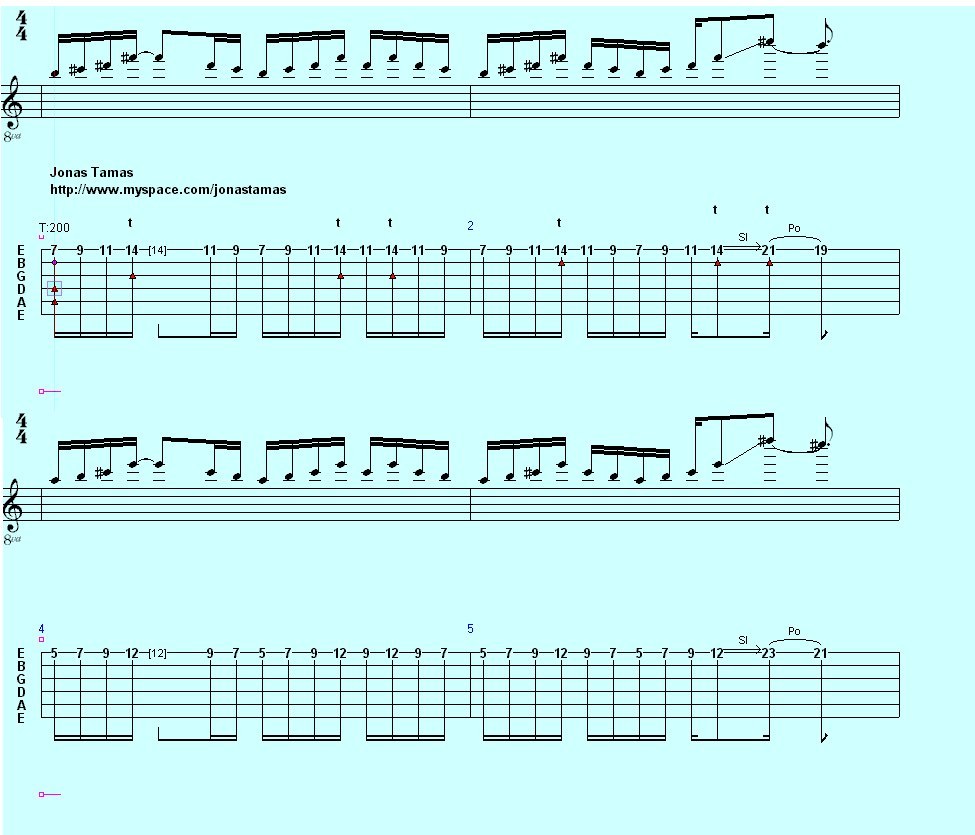Hi fellow guitarists! This time we'll take a look at a less common approach to two handed tapping: sliding with both hands, while continuing the tapping sequence. To begin with, click here to download the sound files for this lesson. The tab for the lesson follows:

In the first bar, grab the first three notes of a B major scale with the left hand on the high E string. These are frets 7, 9 and 11, to be fretted with your first, second and fourth finger, respectively. The right hand taps the 14th fret of the same string, which is the fifth of the scale. I recommend using your second finger for tapping, because this way you keep on holding the pick firmly with your thumb and index finger. However, if you feel like using your index finger, you can safely do this as well.
As shown in bars 1 and 2, you should start playing this four notes, while gradually gaining speed. There is no picking at all, the first note is played with the right hand's second finger instead of the pick, and all the subesquent notes are either legato or tapping. In the tablature, the letter 't' shows the tapped notes. You can use the pattern of this example, or experiment with your own patterns, it is up to you.
Now comes the tricky bit! At the end of the second bar you can see a slide from F sharp to C sharp (from fret 14 to fret 21). This is made by your right hand, i.e. you slide up from a tapped note. Be sure to hold down pretty strong your finger on the fretboard while sliding, otherwise the note starts to choke in.
While you are sliding with your right hand, the pinky of your left hand should also start sliding towards the end of the neck, right to the 19th fret. Try to execute the two sliding movements simultaneously, as you don't have much time if you want to hear a smooth and quick succession of notes.
When both of the hands have arrived to their destination, which means fret 21 for your right hand's middle finger, and fret 19 in case of your right hand's little finger, then it's time to make a pull-off a major second down. In other words, the tapped note (C sharp) has to be pulled off to sound the left-hand-note (H).
In bars 4 and 5 the same procedure is carried out again, but with a different implied chord. This time you will be using notes from an A-lydian scale (A, H, C sharp, D sharp and E), to imitate an A major chord with a raised fourth.
The slide is a bit more difficult here, because your right hand has to travel 11 frets (from fret 12 to fret 23) instead of only 7 frets, which was the case in the first two bars. Another inconvenience can emerge here: as your right hand starts the tapping at fret 12 (see bar 4), your forearm will hide the target note (fret 23), so when you begin to slide, you don't actually see the highest frets.
This second half of the exercise is therefore a good opportunity to develop the 'feel' of the fretboard, thereby you less and less have to look at the neck to get exactly the note you want. The example can be heard in the file 'jonastamas_myspace02.mp3'.
Keep on rockin'.
Jonas Tamas is a composer and guitarist from Budapest, Hungary.
He plays in a Hungarian progressive band called Wind's Eye, who have completed work on their concept album, "The City".